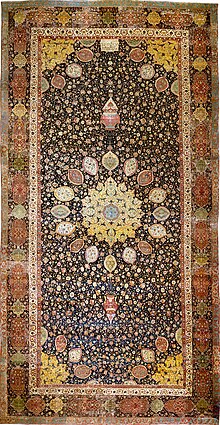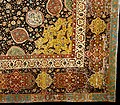Ardabil Carpet


The Ardabil Carpet (or Ardebil Carpet) is the name of two different famous Persian carpets,[1] the larger and better-known now in the Victoria and Albert Museum in London. Originally there were two presumably identical carpets, and the London carpet, as restored and reconstructed in the 19th century, uses sections from both. It now measures 34 ft 3 in × 17 ft 6+7⁄8 in (1,044 cm × 535.5 cm).[2] The other carpet, now in the Los Angeles County Museum of Art, and smaller at 23 ft 7 in × 13 ft 1+1⁄2 in (718.82 cm × 400.05 cm),[3] was made up of the sections in adequate condition unused for the London carpet. Both carpets are now smaller (shorter in particular) than they would have been originally, and there are other fragments in various collections that appear to come from the reconstruction process.[a] The carpets have a typical Tabriz design, with one central medallion and smaller, ornate designs surrounding. Such medallions and shapes were central to the design and reality of Persian gardens, a common symbol of paradise for followers of Islam.[5]
A
Design
The foundation is
I have no refuge in the world other than thy threshold.
There is no protection for my head other than this door.
The work of the servant of the threshold Maqsud of Kashan in the year 946.
Translating this date into the Christian calendar shows that the carpet was woven around the years 1539–40 during the reign of Shah Tahmasp

The design of the central medallion resembles that of the interior side of the dome of the
Designs for prestige carpet commissions were supplied by the court atelier of artists, who also designed for manuscripts, tiling patterns on buildings and other media, giving a uniform style to elite
-
Corner, London
-
Cartouche section, London
-
Border detail, Los Angeles
-
Lamp, Los Angeles
History

Completed after about four years weaving during the rule of the Safavid Shah Tahmasp I in 1539-40, probably in Kashan, the carpets are considered some of the best of the classical Iranian (Persian) school of carpet creation. According to the traditional story, now rather doubted by historians,[4] when new they were placed in the Sheikh Safi al-Din Khānegāh and Shrine Ensemble in Ardabil, but became heavily worn and were sold in 1890[5] to a British carpet dealer who restored one of the carpets using the other and then resold the restored one to the Victoria and Albert Museum.[10]
Many[

This carpet was sold by the dealer Edward Stebbing of Robinson and Company as "The Holy Carpet of the Mosque at Ardebil",[b] stressing the "exceptionalism of the carpet and its provenance as a product of the Safavid royal atelier of Shah Tahmasp, made for the Safavid dynastic shrine at Ardabil". William Morris advised the V&A in the acquisition: "It was William Morris, in his capacity as one of the V&A's Art Referees, who persuaded the Museum to raise, with the aid of public subscription, the then vast sum of £2000 to purchase the carpet in March 1893".[8] Morris wrote in a letter to Thomas Armstrong that "it has no counterpart". Gradually, word came out that there was a second Ardabil carpet. When the Victoria and Albert Museum began to check out the piece in 1914, the historical consensus came to be that the modifications on the current Los Angeles Ardabil to repair the London Ardabil were managed by Ziegler and Company, the first buyer of the carpets from Persian resident Hildebrand Stevens, supposedly using Tabriz or Turkish craftsmen. The second Ardabil had visible changes in its structure, with its borders replaced into a newly woven narrow line while the London Ardabil was thoroughly over-restored. Historians of the time spoke to this, stating 'The highest market value was for complete carpets, rather than damaged ones or fragments. The London carpet was 'a remarkable work of Art', and as Morris has said, of real historical importance, but it had been compromised to suit the market values of 19th century art connoisseurship.' The carpet was for decades displayed hanging on a wall. Since 2006, it has been shown flat in a special glass pavilion in the centre of the Jameel gallery, Room 42 of Islamic art. The lighting is kept very low to prevent fading, and is increased for a brief period each hour.[8]
The second "secret" carpet, smaller, now borderless and with some of the field missing, made up from the remaining usable sections, was sold to the American businessmen
Copies
The Ardabil Carpet was an original design, though in the style of some other Persian carpets of the same period.
Notes
References
Citations
- ^ Mokhberi 2019, p. 118; Beattie 1986, pp. 365–368; Spuhler 1986, pp. 708–709.
- ^ "The Ardabil Carpet". Victoria and Albert Museum. Retrieved 14 September 2021.
- ^ "Ardabil Carpet". LACMA Collections. Retrieved 14 September 2021.
- ^ a b c d e f Beattie 1986, pp. 365–368.
- ^ ISBN 978-0-89236-700-9.
- ^ a b "The Ardabil Carpets". Jozan Magazine on Oriental Rugs. 31 January 2003. Archived from the original on 9 February 2007.
Sources: Los Angeles County Museum of Art, The Oriental Rug Lexicon by Peter F. Stone.
- ^ Shahram Razavi. "The famous Ardebil Persian rug". WorldIsRound.com. Archived from the original on 22 August 2007.
- ^ a b c d e Hillyer & Pretzel 2005.
- ^ The Editors of Encyclopædia Britannica. "Ardabil Carpet". Encyclopedia Britannica. Retrieved 1 January 2017.
- ^ Hillyer & Pretzel 2005; Beattie 1986, pp. 365–368.
- ^ Beattie 1986, pp. 365–368: "Judging from a small-scale plan of the shrine complex the two carpets, end to end, would fit into the sanctuary of the Gowhar-Šād mosque, and possibly elsewhere if used singly."
- his sister, when she married the Shah of Iran.
- ^ Jennifer Wearden (July 1995). "The Surprising Geometry of the Ardabil Carpet". Paper presented at Ars Textrina International Textiles Conference, University of Leeds. Victoria and Albert Museum.
Bibliography
- Beattie, M. (1986). "Ardabīl Carpet". In ISBN 978-0-71009-104-8.
- Hillyer, Lynda; Pretzel, Boris (Spring 2005). "The Ardabil Carpet – a new perspective". Conservation Journal (49). Victoria and Albert Museum. Archived from the original on 7 February 2007.
- Mokhberi, Susan (2019). The Persian Mirror: Reflections of the Safavid Empire in Early Modern France. Oxford University Press. ISBN 978-0190884802.
- Spuhler, F. (1986). "Carpets and Textiles". In Lockhart, Laurence; ISBN 0-521-20094-6.
External links
- Armstrong, Dorothy (2018). "Inventing the Ardabil Carpet: A Case Study in the Appropriation and Transformation of a Persian Artifact". Iran: Journal of the British Institute of Persian Studies. 58 (1): 110–130. S2CID 192690324.
- The Ardabil Carpet at the Los Angeles County Museum of Art




